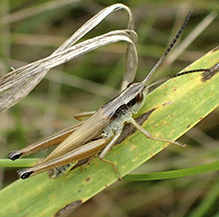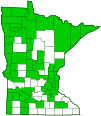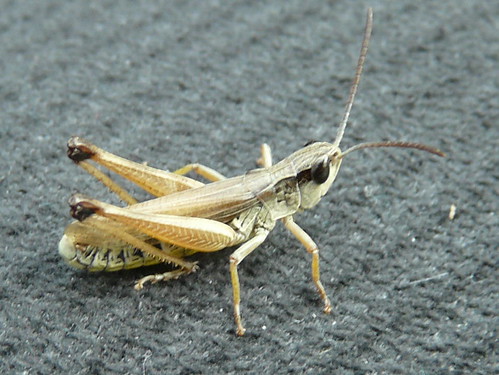marsh meadow grasshopper
(Pseudochorthippus curtipennis)
Conservation • Description • Habitat • Ecology • Distribution • Taxonomy
Conservation Status |
|
|||||||
| IUCN Red List | not listed |
|||||||
| NatureServe | N5 - Secure |
|||||||
| Minnesota | not listed |
|||||||
Description |
||
Marsh meadow grasshopper is a common, medium-small, stridulating, slantface grasshopper. It occurs in southern Canada and in the northern two-thirds of the United States. It is common throughout Minnesota. It is found from July through October or to the first frost in wet prairies, damp meadows, open woodlands, streamsides, roadside ditches, and moist depressions in fields (swales). The female is ⅝″ to 15⁄16″ (15 to 24 mm) in length. The male is smaller, ½″ to ⅝″ (13 to 15 mm) in length. The top of the head is triangular when viewed from the side, narrowly angled on the male, more broadly angled on the female. The face is distinctly slanted. On the upper part of the forehead (fastigium), there is a small but distinct narrow, oblong impression (foveola) on each side. The foveolae are visible when viewed from above. The antennae are flattened near the base. On the female they are shorter than the length of the head and front part of the body (pronotum) combined. On the male they are longer and thickened. The body is slender and compressed. The color is highly variable. The upper side is usually light brown. The pronotum is saddle-shaped, flat above with the sides abruptly angled downward. A black bar on each side extends from behind the compound eye across the top half of the side (lateral lobe) of the pronotum. The sides of the body, the face, and the lower half of the lobes of the pronotum may be green, brown, or gray. Each segment of the abdomen is banded with green and black. When viewed from the side, the sides of the body appear spotted with black. The underside of the abdomen is yellow. The forewings (tegmina) are light brown, oval, and variable in length. They are about three-fourths the length of the abdomen on most females and reach the tip of the abdomen on most males, but they may be shorter or longer on either sex. On the hind pair of legs, the outer face of the robust, third segment (femur) is not banded. The fourth segment (tibia) is usually yellow, rarely orange. It has a row of 12 or 13 spines on the outer margin. The spines, at least at the tip, are black. The “knees”, the end of the femur and base of the tibia, are black. |
||
Size |
||
Male: ½″ to ⅝″ (13 to 15 mm) Female: ⅝″ to 15⁄16″ (15 to 24 mm) |
||
Similar Species |
||
Habitat |
||
Wet prairies, damp meadows, open woodlands, streamsides, roadside ditches, and swales |
||
Ecology |
||
Season |
||
July to October (CCESR) |
||
Behavior |
||
|
||
Life Cycle |
||
|
||
Food |
||
Grasses and sedges |
||
Distribution |
||||
|
Sources Haarstad, J. 1990. The Acrididae of Minnesota. Final report submitted to the Minnesota Department of Natural Resources. 28 pp. |
|||
| 2/17/2023 | ||||
Occurrence |
||||
Common throughout Minnesota |
||||
Taxonomy |
|||
Order |
Orthoptera (grasshoppers, crickets, and katydids) | ||
Suborder |
Caelifera (grasshoppers, locusts, and allies) | ||
| Infraorder | Acrididea (grasshoppers) | ||
Superfamily |
Acridoidea (short-horned grasshoppers and locusts) | ||
Family |
Acrididae (short-horned grasshoppers) | ||
Subfamily |
Gomphocerinae (stridulating slantface grasshoppers) | ||
Tribe |
Gomphocerini | ||
Genus |
Pseudochorthippus | ||
This species was formerly classified as Chorthippus curtipennis. A recent molecular phylogenetic analysis of the parallelus group of the genus Chorthippus (Default, 2012) showed that the group is closer to Omocestus and Stenobothrus than to Chorthippus, and proposed placing the group in the new genus Pseudochorthippus. |
|||
Subordinate Taxa |
|||
marsh meadow grasshopper (Pseudochorthippus californicus) marsh meadow grasshopper (Pseudochorthippus curtipennis) |
|||
Synonyms |
|||
Chorthippus curtipennis Locusta curtipennis |
|||
Common Names |
|||
marsh meadow grasshopper marsh meadow locust meadow grasshopper short-winged brown grasshopper |
|||
Glossary
Fastigium
On some insects, especially Orthoptera: the upper part of the forehead, between and often extending in front of the compound eyes.
Femur
On insects and arachnids, the third, largest, most robust segment of the leg, coming immediately before the tibia. On humans, the thigh bone.
Pronotum
The exoskeletal plate on the upper side of the first segment of the thorax of an insect.
Tegmen
The modified, leathery front wing of grasshoppers and related insects that protects the hindwing. It may also serve as a camouflage, a defensive display, or a sound board. Plural: tegmina.
Tibia
The fourth segment of an insect leg, after the femur and before the tarsus (foot). The fifth segment of a spider leg or palp. Plural: tibiae.
Vertex
The upper surface of an insect’s head.
Visitor Photos |
|||||
Share your photo of this insect. |
|||||
| This button not working for you? Simply email us at info@MinnesotaSeasons.com. Attach one or more photos and, if you like, a caption. |
|||||
Babette Kis |
|||||
Chortihippus curtipennis marsh meadow grasshopper |
 |
||||
MinnesotaSeasons.com Photos |
|||||
|
|||||

Visitor Videos |
|||
Share your video of this insect. |
|||
| This button not working for you? Simply email us at info@MinnesotaSeasons.com. Attach a video, a YouTube link, or a cloud storage link. |
|||
Other Videos |
|||
| Marsh Meadow Grasshopper (Chorthippus curtipennis) stridulating Andalyne Tofflemire |
|||
About
May 19, 2016 Male marsh meadow grasshopper stridulating with legs and wings. Slant faced grasshopper subfamily Gomphocerinae. July 20 2013, Earl Rowe Provincial Park, Ontario. |
|||

Created: 2/17/2023
Last Updated:




